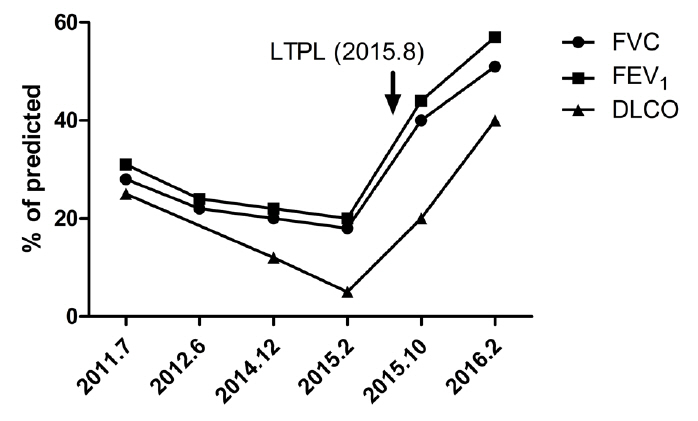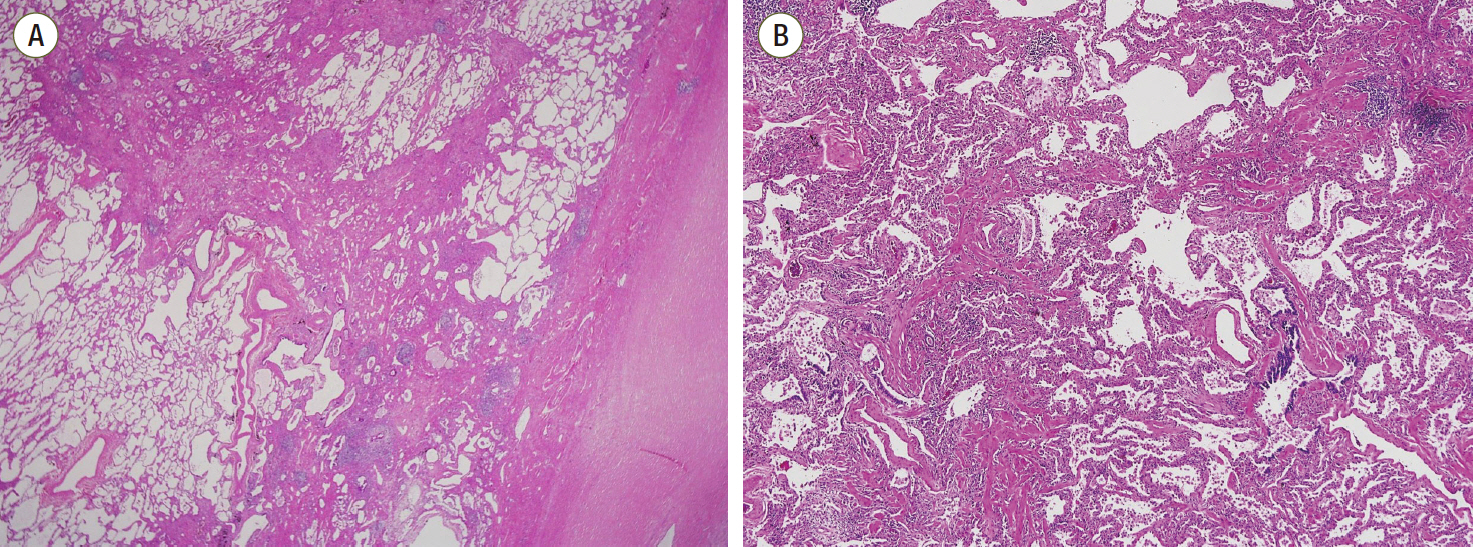Korean J Crit Care Med.
2016 May;31(2):146-151. 10.4266/kjccm.2016.31.2.146.
Lung Transplantation for Chronic Humidifier Disinfectant-Associated Lung Injury
- Affiliations
-
- 1Department of Pulmonary and Critical Care Medicine, Asan Medical Center, University of Ulsan College of Medicine, Seoul, Korea. sbhong@amc.seoul.kr
- 2Department of Pathology, Asan Medical Center, University of Ulsan College of Medicine, Seoul, Korea.
- 3Department of Thoracic and Cardiovascular Surgery, Asan Medical Center, University of Ulsan College of Medicine, Seoul, Korea.
- KMID: 2350923
- DOI: http://doi.org/10.4266/kjccm.2016.31.2.146
Abstract
- In the spring of 2011, a cluster of lung injuries caused by humidifier disinfectant (HD) usage were reported in Korea. Many patients required mechanical ventilation, extracorporeal membrane oxygenation, and even lung transplantation (LTPL). However, the long-term course of HD-associated lung injury remains unclear because the majority of survivors recovered normal lung function. Here we report a 33-year-old woman who underwent LTPL approximately four years after severe HD-associated lung injury. The patient was initially admitted to the intensive care unit and was supported by a high-flow nasal cannula. Although she had been discharged, she was recurrently admitted to our hospital due to progressive lung fibrosis and a persistent decline in lung function. Finally, sequential double LTPL was successfully performed, and the patient's clinical and radiological findings showed significant improvement. Therefore, we conclude that LTPL can be a therapeutic option for patients with chronic inhalation injury.
Keyword
MeSH Terms
Figure
Reference
-
References
1. Tredget EE, Shankowsky HA, Taerum TV, Moysa GL, Alton JD. The role of inhalation injury in burn trauma. A Canadian experience. Ann Surg. 1990; 212:720–7.
Article2. Suzuki M, Aikawa N, Kobayashi K, Higuchi R. Prognostic implications of inhalation injury in burn patients in Tokyo. Burns. 2005; 31:331–6.
Article3. Hong SB, Kim HJ, Huh JW, Do KH, Jang SJ, Song JS, et al. A cluster of lung injury associated with home humidifier use: clinical, radiological and pathological description of a new syndrome. Thorax. 2014; 69:694–702.
Article4. Kim HJ, Lee MS, Hong SB, Huh JW, Do KH, Jang SJ, et al. A cluster of lung injury cases associated with home humidifier use: an epidemiological investigation. Thorax. 2014; 69:703–8.
Article5. Kim KW, Ahn K, Yang HJ, Lee S, Park JD, Kim WK, et al. Humidifier disinfectant-associated children’s interstitial lung disease. Am J Respir Crit Care Med. 2014; 189:48–56.6. Lee JH, Kim YH, Kwon JH. Fatal misuse of humidifier disinfectants in Korea: importance of screening risk assessment and implications for management of chemicals in consumer products. Environ Sci Technol. 2012; 46:2498–500.
Article7. Suda T, Sato A, Ida M, Gemma H, Hayakawa H, Chida K. Hypersensitivity pneumonitis associated with home ultrasonic humidifiers. Chest. 1995; 107:711–7.
Article8. Kim YB, Choi SJ, Yang YS, Kim YH, Song CW, Cho JW, et al. Comparative pulmonary response to aerosolized humidifier disinfectants by intratracheal instillation and inhalation exposure. In : 2013 Annual Meeting Poster #207; 2013.9. Christie JD, Edwards LB, Aurora P, Dobbels F, Kirk R, Rahmel AO, et al. The registry of the international society for heart and lung transplantation: twenty-sixth official adult lung and heart-lung transplantation report-2009. J Heart Lung Transplant. 2009; 28:1031–49.
Article10. Barrio J, Sánchez C, Vicente R, Ramos F, Montero R, Morales P, et al. Successful sequential double-lung transplantation for adult respiratory distress syndrome after long-term mechanical ventilation. Eur J Anaesthesiol. 2004; 21:326–7.
Article11. Hayes D Jr. Lung transplantation for bronchiectasis due to smoke inhalation. Burns. 2011; 37:e24–8.
Article12. Pirjavec A, Kovic I, Lulic I, Zupan Z. Massive anhydrous ammonia injury leading to lung transplantation. J Trauma. 2009; 67:E93–7.
Article13. Millar J, Lutton S, O’Connor P. The use of high-flow nasal oxygen therapy in the management of hypercarbic respiratory failure. Ther Adv Respir Dis. 2014; 8:63–4.
Article14. Nilius G, Franke KJ, Domanski U, Rühle KH, Kirkness JP, Schneider H. Effects of nasal insufflation on arterial gas exchange and breathing pattern in patients with chronic obstructive pulmonary disease and hypercapnic respiratory failure. Adv Exp Med Biol. 2013; 755:27–34.
Article15. Sztrymf B, Messika J, Bertrand F, Hurel D, Leon R, Dreyfuss D, et al. Beneficial effects of humidified high flow nasal oxygen in critical care patients: a prospective pilot study. Intensive Care Med. 2011; 37:1780–6.
Article16. Frat JP, Thille AW, Mercat A, Girault C, Ragot S, Perbet S, et al. High-flow oxygen through nasal cannula in acute hypoxemic respiratory failure. N Engl J Med. 2015; 372:2185–96.
Article17. Kang BJ, Koh Y, Lim CM, Huh JW, Baek S, Han M, et al. Failure of high-flow nasal cannula therapy may delay intubation and increase mortality. Intensive Care Med. 2015; 41:623–32.
Article
- Full Text Links
- Actions
-
Cited
- CITED
-
- Close
- Share
- Similar articles
-
- Major concerns regarding lung injury and related health conditions caused by the use of humidifier disinfectant
- Mental health impact on a humidifier disinfectant disaster victim: a case report
- Problems with diagnostic criteria for humidifier disinfectant lung injury (HDLI): two cases of radiologically improved HDLI
- Frequency of Humidifier and Humidifier Disinfectant Usage in Gyeonggi Provine
- Comparison of Long Term Follow-up Chest CT Imaging in Adult and Pediatric Patients with Humidifier Disinfectant-related Lung Injury





